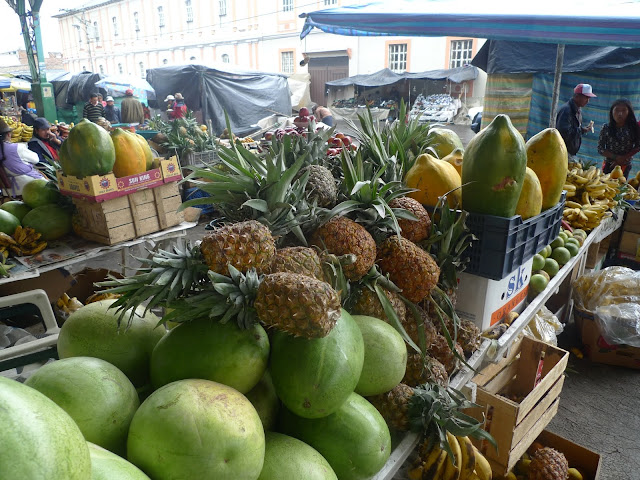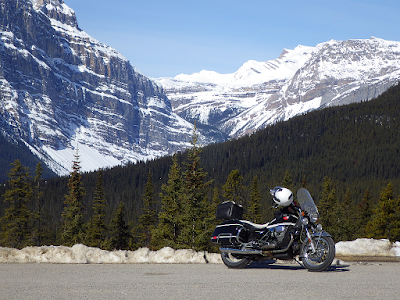Comida Post
Comida means food and also lunch or dinner. One of my fans (thanks Dave) was asking about food, and how I am making out. First off in Latin America they don't eat when we eat. Most restaurants do not open until 9 AM for desayuno (breakfast). Desayuno is best eaten just before noon, and here is why.
This was today's desayuna, sopa (soup) with large chunks of potato, a beef rib, very tiny noodles, and unidentifiable yellow blobs floating on top, a glass of orange juice, a banana, a plate with arroz (rice), carne (meat), and frijoles (beans). In Ecuador this set me back a whole $1.75, I thought I was robbing the lady, she even wanted to give me back the 25 cent tip I left. Another desayuna came with the above, a chicken leg instead of carne, and two very well done sunny side up eggs, and a pan (bun). I think that one was 2,700 Columbian pesos or about the same as Ecuador, but it sounded better. These meals are not what I want to be eating first thing in the AM, but I usually skip breakfast so this is not a problem.
Comida (dinner) is supposed to be in the afternoon and cena (supper) about 7 to 9 PM. My problem is that the type of restaurant where locals eat do not have menus, and if they do it is all wishful thinking anyway, as most items are named so that I can't tell what it is and often not available. People just ask for stuff and they get it, they have tbeen there before so they know what to order.
At one restaurant I explained that I had not a clue and asked the lady who waited on me to give me something typical. This is what I got. Beef sliced very thin and very well done, like a schnitzel, papas (potatoes) arroz, and an excellent cucumber salad with onions and tomatoes and other stuff. Meals are light on meat, with lots of arroz and frijoles. Meat even pollo (chicken) is usually sliced very thin like a schnitzel. Oh, and the beer is excellent everywhere, I always make sure to try the local brew. The cooking I find a bit on the bland side, spices are not used flavors are very subtle. There is usually a salsa that is supplied on the side, and it is usually spicy hot.
There is a wide variety of vegetables and fruits most of which I do not recognize, all grown locally, probably on the side of a hill.
 It is brought to town, probably in a bus, or a small truck or a small truck that is also a bus, and carried to market or a store.
It is brought to town, probably in a bus, or a small truck or a small truck that is also a bus, and carried to market or a store.
The market in Riobamba was fascinating, so I am going to do a seque.
And for those of us (like me) who must have a morning coffee, and are up early, will need to find a panaderia (bake shop), or a roadside stall, usually the first businesses to open (7 AM). (Licore stores are usually open 24 horas.) More often than not you are given a cup of hot water and jar of instant. The pastries are not very good, they taste like the day old stuff from Safeway, which they probably are, (or the equivalent). They don't seem to make their own in the panaderias I have been in. The bread (pan) is very different from Norte Americano pan, it is more like cake than bread, I don't like it much.
The reason comida has remained a mystery so far is that after desayuna I can't even think about food until cena. But if looking for a snack, an empenada, a deep fried dumpling filled with carne (meat) or queso (cheese) will do the trick, they come in all sizes, the one pictured is huge, they can also be much smaller, like a wonton.
Street venders also sell all kinds of interesting snack food, a shish-ke-bob meat sliced very thin on a stick is my favorite. Leche con jugo is milk mixed with fruit juice, and is delicious. In Panama and Costa Rica vendors sell cold coconut milk with chunks of coconut in it. This can also come in a can alongside your regular pop and energy drinks in convenience stores.
This was today's desayuna, sopa (soup) with large chunks of potato, a beef rib, very tiny noodles, and unidentifiable yellow blobs floating on top, a glass of orange juice, a banana, a plate with arroz (rice), carne (meat), and frijoles (beans). In Ecuador this set me back a whole $1.75, I thought I was robbing the lady, she even wanted to give me back the 25 cent tip I left. Another desayuna came with the above, a chicken leg instead of carne, and two very well done sunny side up eggs, and a pan (bun). I think that one was 2,700 Columbian pesos or about the same as Ecuador, but it sounded better. These meals are not what I want to be eating first thing in the AM, but I usually skip breakfast so this is not a problem.
Comida (dinner) is supposed to be in the afternoon and cena (supper) about 7 to 9 PM. My problem is that the type of restaurant where locals eat do not have menus, and if they do it is all wishful thinking anyway, as most items are named so that I can't tell what it is and often not available. People just ask for stuff and they get it, they have tbeen there before so they know what to order.
At one restaurant I explained that I had not a clue and asked the lady who waited on me to give me something typical. This is what I got. Beef sliced very thin and very well done, like a schnitzel, papas (potatoes) arroz, and an excellent cucumber salad with onions and tomatoes and other stuff. Meals are light on meat, with lots of arroz and frijoles. Meat even pollo (chicken) is usually sliced very thin like a schnitzel. Oh, and the beer is excellent everywhere, I always make sure to try the local brew. The cooking I find a bit on the bland side, spices are not used flavors are very subtle. There is usually a salsa that is supplied on the side, and it is usually spicy hot.
There is a wide variety of vegetables and fruits most of which I do not recognize, all grown locally, probably on the side of a hill.
 It is brought to town, probably in a bus, or a small truck or a small truck that is also a bus, and carried to market or a store.
It is brought to town, probably in a bus, or a small truck or a small truck that is also a bus, and carried to market or a store.The market in Riobamba was fascinating, so I am going to do a seque.
And for those of us (like me) who must have a morning coffee, and are up early, will need to find a panaderia (bake shop), or a roadside stall, usually the first businesses to open (7 AM). (Licore stores are usually open 24 horas.) More often than not you are given a cup of hot water and jar of instant. The pastries are not very good, they taste like the day old stuff from Safeway, which they probably are, (or the equivalent). They don't seem to make their own in the panaderias I have been in. The bread (pan) is very different from Norte Americano pan, it is more like cake than bread, I don't like it much.
The reason comida has remained a mystery so far is that after desayuna I can't even think about food until cena. But if looking for a snack, an empenada, a deep fried dumpling filled with carne (meat) or queso (cheese) will do the trick, they come in all sizes, the one pictured is huge, they can also be much smaller, like a wonton.
Street venders also sell all kinds of interesting snack food, a shish-ke-bob meat sliced very thin on a stick is my favorite. Leche con jugo is milk mixed with fruit juice, and is delicious. In Panama and Costa Rica vendors sell cold coconut milk with chunks of coconut in it. This can also come in a can alongside your regular pop and energy drinks in convenience stores.













Comments
Post a Comment